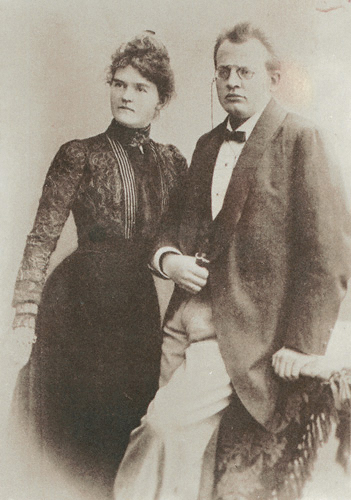1. Munich
Reger gives lied recitals in Munich, Berlin and also Leipzig, where Karl Straube takes up his post as organist of St. Thomas in March, among other things with a Reger recital. In Munich, the situation comes to a head; the premiere of his combinatorially and harmonically extremely complicated and expressive Piano Quintet in C minor, Op. 64, on 1 May is preceded by tumultuous scenes, but the reception by the audience is brilliant.
In the euphoria of the first months of marriage, Reger composes his Gesang der Verklärten , Op. 71, which increases the differentiated compositional technique of the Piano Quintet to great heights. At the same time, Reger devotes a large portion of his time to the editing of Hugo Wolf’s musical estate, which he also promotes in an essay (RWV Schriften A3)1.

His innovative and practice-oriented Beiträge zur Modulationslehre (RWV Schriften A1) are rejected by Lauterbach & Kuhn but, after being printed by the publishing house C.F. Kahnt Nachf., become very popular, which is reflected in a considerable number of new editions and translations into many languages, including Russian and Japanese. Reger gets so upset by a disparaging review of the Contributions to the Theory of Modulation by Arthur Smolian Arthur Smolian 2 that he writes an outraged article (Ich bitte ums Wort! [RWV Schriften A2]), which he follows up with another one on the same matter (Mehr Licht [RWV Schriften A4]) in the next year; Smolian refuses to be provoked into a fight. The Violin Sonata in C major, Op. 72, with the unmistakable themes related to the tone letters S-c-h-a-f-e (sheep) and A-f-f-e (ape), which Reger wants to dedicate to the critics as a reply to the accusation of not composing comprehensibly, is written on commission.
Straube plays Reger's Opera 27 and 57 at the Basel Tonkünstlerfest of the ADMV on the unfit Münster organ in need of renovation and inspires the composer to write a chorale-free concert work for organ; Reger dedicates his Variations and Fugue on an original theme in F-sharp minor, Op. 73, to him in memory of the Basel encounter. The first Reger bust is made by the Munich sculptor Theodor von Gosen, to whom Reger dedicates his avant-garde String Quartet in D minor, Op. 74, in gratitude.
Postal items from this year whose sender or addressee is Max Reger.
Images from the Max Reger Foto Gallery that originate from this year and have a direct reference to Max Reger.
Object reference
Max Reger Biography – 1903, in: Reger-Werkausgabe, www.reger-werkausgabe.de/bio_1903.html, version 3.1.1, 31st January 2025.
Information
This is an object entry from the RWA encyclopaedia. Links and references to other objects within the encyclopaedia are currently not all active. These will be successively activated.